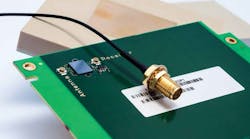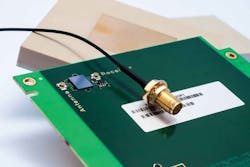Tablet Sales May Be Declining, But Technology Launches Remain Strong
Tablet sales are set to tumble, according to IDC. The market-research firm predicts that the substantial 51% market growth recorded in 2013 is likely to decline to around 20% this year. Even with the decline, that translates into 260 million units being shipped worldwide. Whether this situation should be called a downturn or merely market stabilization is debatable. But what is clear to analysts is that tablet users are becoming less inclined to upgrade to higher-performing models. Interestingly, this cooling of the tablets market was not reflected in the scores of corporate announcements and new technology launches from the 1400 exhibiting companies at this year’s Mobile World Congress (MWC) event in Barcelona.
This file type includes high resolution graphics and schematics when applicable.
Among these announcements, the collaborative result between research organization Imec and satellite-navigation specialist Septentrio is of particular interest. They have developed an integrated RF antenna element for a multi-frequency Global Navigation Satellite System (GNSS) antenna for GPS, GLONASS, BeiDou, and GALILEO (see photo). Developed within the EU’s Seventh Framework Programme, called HANDHELD, the antenna can be integrated into multi-frequency handheld GNSS devices that are designed for high-precision location applications (up to 1 cm).
Internationally, it is well known that the most prominent satellite navigation system is the United States’ Global Positioning System (GPS). By comparison, however, first-generation GPS receivers provide accuracy of just a few meters when relying solely on the navigation satellites. With advances in technology and ever-increasing demands on the existing GPS, there was obvious motivation to develop new systems. In addition to GPS III, examples include Russia’s GLONASS, Europe’s GALILEO, and China’s BeiDou. All of these next-generation GNSSs aim to achieve higher accuracy and integrity.
To optimally serve these systems, Imec and Septentrio co-developed their compact antenna by integrating Imec’s GNSS antenna and Septentrio’s GNSS RF front end. According to Imec, its antenna design meets the demands of the high-accuracy GNSS market while remaining small enough to be used in handheld devices. The antenna simultaneously covers all GPS, GLONASS, and GALILEO bands. Reportedly, it offers uniform gain and phase coverage over the complete upper hemisphere while suppressing unwanted reflected signals below or in the vicinity of the GNSS receiver.
According to Septentrio, its GNSS RF front end provides very good out-of-band interference rejection. It can therefore avoid device self-interference with other radiation sources, such as Bluetooth and WLAN radios. It also is less susceptible to other ambient intentional and non-intentional interference.
From Barcelona To Nuremberg
At the same time that the MWC was convening in Spain, another event—Embedded World—was taking place in Nuremberg. There, wireless-connectivity specialist CSR reported that it has teamed up with ARM to use its mbed platform as a component partner. This industry venture is designed to nurture the growth of the Internet of Things (IoT). Thanks to this arrangement, the mbed community will have access to CSR Bluetooth, Bluetooth Smart, WiFi, and GPS connectivity solutions. This partnership also will facilitate the integration of those solutions into existing microcontroller projects.
The ARM mbed IoT device development platform is an initiative that provides hard and software building blocks to developers. In doing so, it lowers the barrier of entry for the rapid development of Internet-connected products and concepts based on ARM microcontrollers. The project also promises to ease the integration of connectivity and software components.
IoT Technology First
In addition, CSR recently unveiled what it describes as a technically disruptive Bluetooth Smart solution, which is designed to place smartphones at the center of the IoT. Called CSR Mesh, it allows an almost infinite number of Bluetooth Smart-enabled devices to be networked and controlled from a single smartphone, tablet, or PC. The solution combines a configuration and control protocol with CSR’s Bluetooth Smart devices including the CSR101x and CSR8811. As a result, consumers can control any Bluetooth Smart-enabled device in the home (including lighting, heating, appliances, and security systems) from wherever they are.
This file type includes high resolution graphics and schematics when applicable.


